Rasa part 3 By HH Bhanu Swami Maharaj | ISKCON JAPAN | Nov 30, 2021
So our general subject here is called Vibhava, that is the person’s involved in rasa. We need people to make rasa. So we have the object of our love, that is Krishna, and then we have the devotee. So we’ve been discussing all about Krishna’s wonderful qualities. But in order to have rasa, we need the devotee. So the devotee is called the Asraya.
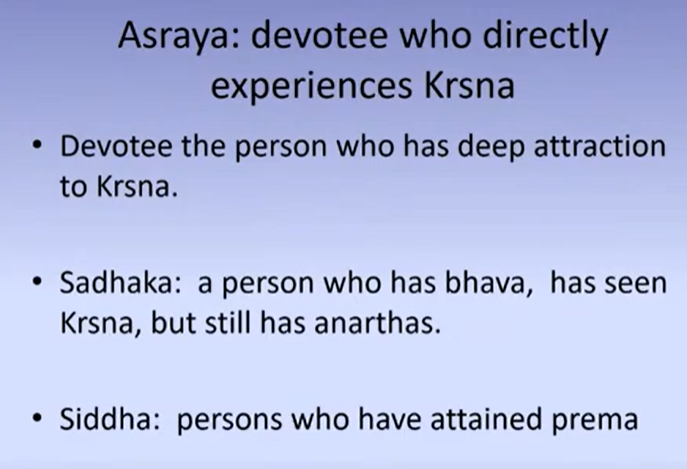
So when we’re doing Sadhana bhakti, we do not have a direct realization of rasa. But when one gets to the Bhava stage after Sadhana, then one begins to experience a little rasa. And if one gets to Prema, then one gets an experience of full rasa. So they are classified, the Sadhaka is the person in Bhava, and the Siddha is the person in Prema.
So the Siddha, there’s two types of Siddhas. Those that attain Prema, that is they do Sadhana bhakti, they get bhava, they get Prema. So in other words, people of this material world. So they may get it by Sadhana or by mercy. So examples of mercy – getting Prema by mercy is, Sukadeva Goswami and Bali Maharaj. And so the other one, they don’t do Sadhana, they already have it eternally, those are called the Nitya Siddhas.

So when one gets to that perfect stage, one can manifest up to 55 qualities of Krishna. Sometimes of course we say 50 qualities, but then there’s an extra five qualities that sometimes Shiva has and sometimes Brahma has. So devotees can get up to that number of qualities.

So, then we have different types of devotees. So they are classified according to their rasas. So we have those in Santa rasa, those in Dasya rasa, those in Sakhya rasa, those in Vatsalya rasa, those in Madhurya rasa. Of course, we’ll find all five manifest in relation to Krishna.
Generally, with the avatar forms and with Vishnu, one could experience Santa or Dasya only. So in worshipping Vishnu or Narsimhadev, we don’t aspire for Vatsalya, or Sakhya or Madhurya, we only aspire for Dasya.
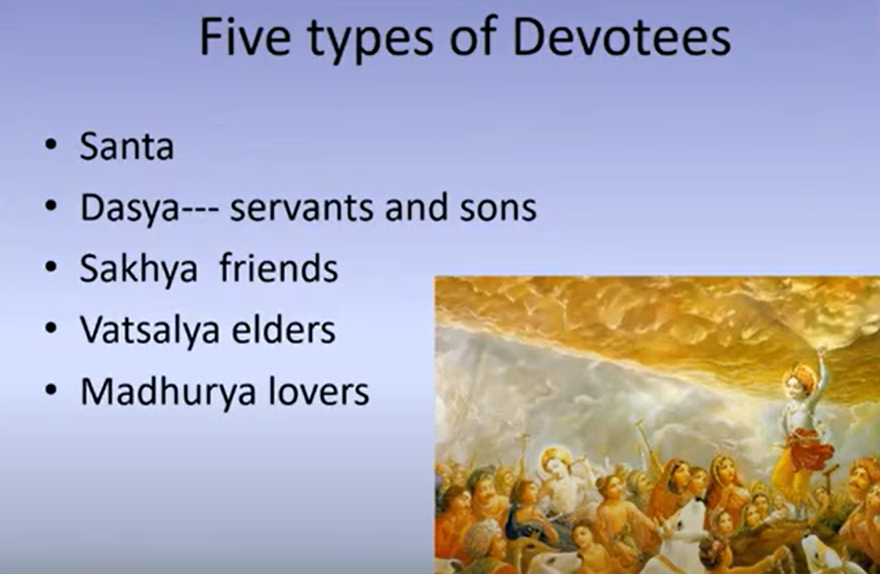
So the devotees are the Asraya, they remember or see Krishna and certain aspects of Krishna will stimulate the devotees’ love. These are called Uddipana. So that means a stimulus or something that excites the love. Just as in the material world, we get a similar type of object that may excite one’s emotions. There’s a famous example in Ramanuja’s pastimes. There was one man, he was very much in love with a woman. He was most attracted to her eyes. So he would walk in front of her backwards so that he could see her [Laughs] eyes all the time [Laughs]. He was looking at her eyes [Laughs]. So Ramanuja saw this [Laughs]. And then he said, well look, I’ll show you much more beautiful eyes than that [Laughs]. So he took him to the Srirangam deity and there he showed him the deity with his eyes and then that man fell in love with Vishnu instead, because of his eyes.

So there are many things about Krishna which will stimulate love. It may be stimulus for the eye or for the nose – smell / fragrance or the ear. So many, many types of things are there. And in the Nectar of Devotion, Rupa Goswami gives a long, long list. And then he gives examples of how each element is a stimulus for a devotee’s love.
So one of the divisions is the qualities of Krishna, they will stimulate love. So Krishna has bodily qualities, mental qualities, and speech qualities [Laughs]. So bodily qualities, one of them is His age. Perhaps Krishna has three ages – His baby years, His boyhood years, and His youth years.
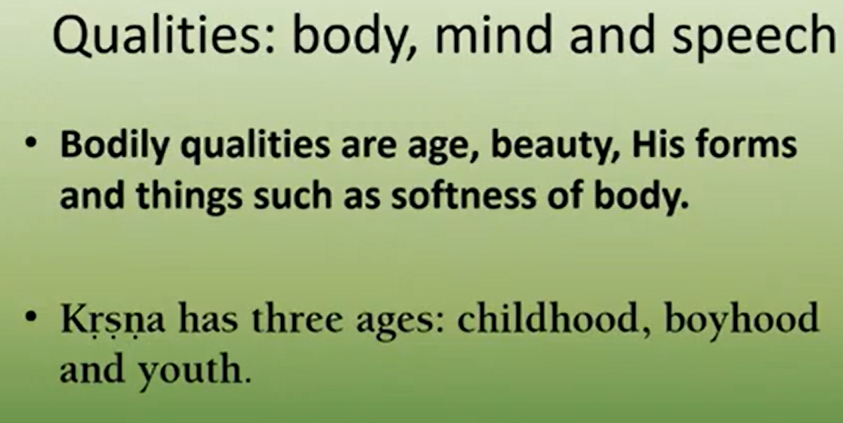
So Krishna goes through this Kaumara period from birth up to five years. And this is particularly a stimulus for the Vatsalya Rasa devotees. So for instance, Mother Yasoda, she expresses her love very nicely for this young baby form of Krishna. And even when He is older, she will somehow see these baby qualities of Krishna [Laughs].
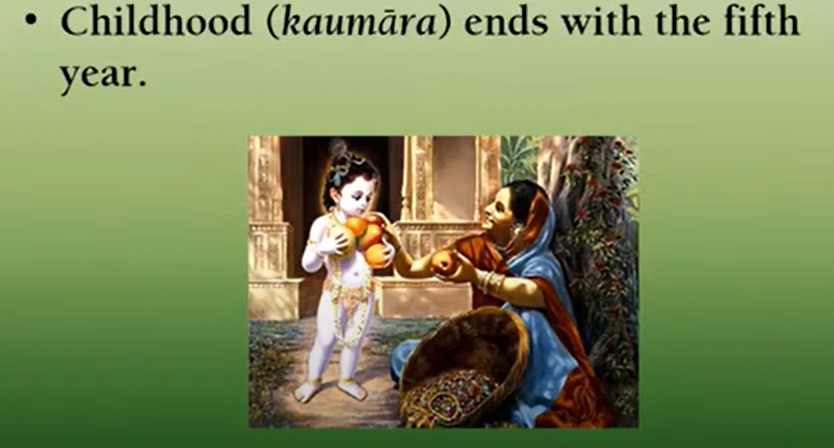
When Krishna is five years old till He is ten years old, that is the usual Pauganda period. So at this age, Krishna makes a lot of friends. And he plays with the friends a lot. So this is the age where Sakhya Rasa becomes very prominent in Krishna’s pastimes. So after the killing of Aghasura, Krishna entered his Pauganda period. So in the Bhagavatam, there is a whole series of chapters, after…chapter 15 onwards, which describe His boyhood pastimes of Sakhya Rasa in the Pauganda period.

So though the Pauganda usually lasts till the tenth year, actually Krishna began his next age, the Kaisora age, a little earlier, when He was eight years old [Laughs]. After that, after the Pauganda period, we have the Kaisora period, and that lasts till the sixteenth year.
After that is called Yauvana. Now we can say that’s early adulthood [Laughs]. However, it is said that Krishna never ages past Kaisora [Laughs]. So He went to Mathura when He was 11 years old, when He was in His Kaisora period, and He did not age beyond Kaisora period, even in Dwaraka. So the Kaisora period is particularly a stimulus for Madhurya Rasa. So when Krishna begins to perform the Rasa Lila with the gopis, that is Kaisora period. However, the Kaisora period is also attractive to the people in Sakhya Rasa and even to the people in Vatsalya Rasa. So these different ages themselves have an attraction. So they are Uddipina, a stimulus for the love.

Another aspect of Krishna’s body is His beauty and His particular form / His shape. So the definition of beauty is the limbs get arranged in the most attractive manner. All the limbs are in proper size in the proper place [Laughs] that is beauty. So the eyes, the nose, and the mouth, and the forehead, and the ears, and the hands, and the feet, and the legs, they are all the right proportions arranged very nicely. We find, however that, that beauty changes because there is beauty when Krishna is in His Kaumara period, when He is below five years old. We have Krishna’s beauty in His Pauganda period, a little different, and then we have Krishna’s beauty in His Kaisora period, which is very, very attractive to the gopis.

And before we talk about the form of Krishna, so form means that when He puts ornaments on, then the ornaments show their wonderful qualities because of his particular form.
In other words, the ornaments show their true beauty when we have a proper form.

Another aspect of body is His softness or tenderness. It’s so soft that even a soft object touching His body becomes intolerable. So even if a soft flower petal touches Him that is very very sensitive [Laughs]. For that reason, the Gopis often lament Krishna goes to the forest and then He’s walking on the grass and then the grass may cut His feet because His feet are so tender.
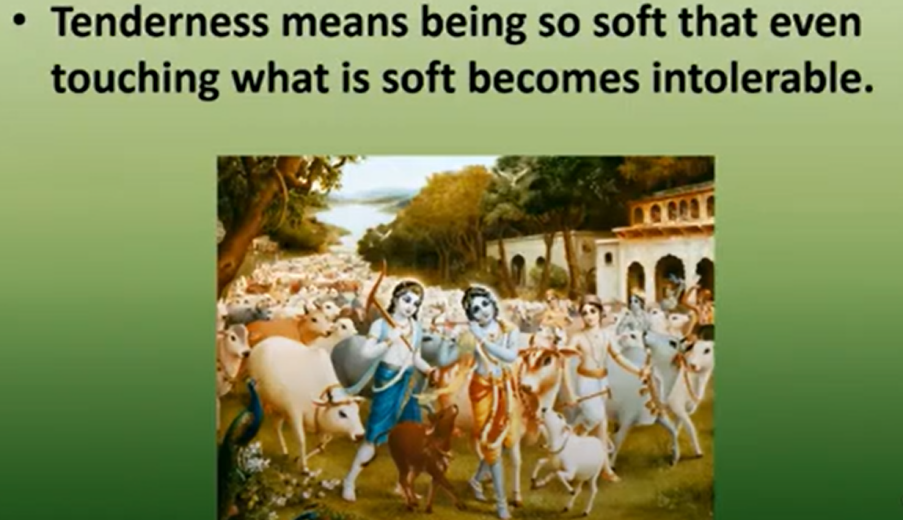
So the activities of Krishna act as a stimulus for his love. So when the devotees of Vrindavan see a particular pastime then that excites their love. And if they remember that pastime later on, that also stimulates their love. For instance, the Rasa lila that will stimulate, that obviously stimulated all the Gopis’ love and when they remember that in the day that further stimulates their love.
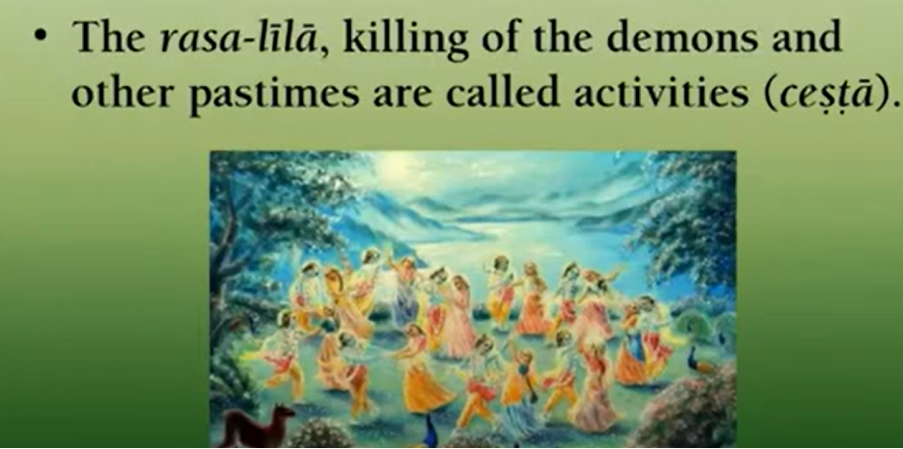
But when Krishna kills a demon like Bakasura or Aghasura that stimulates the love of the cowherd boys and so the cowherd boys begin to describe this pastime to everybody else. Everybody else then hearing about the pastime they get excited by Krishna [Laughs].
So their clothing, ornaments and decorations of Krishna they will stimulate love. So often we hear Krishna wears a yellow dhoti and a top cloth, so that yellow cloth people remember that and immediately their love for Krishna is stimulated. Or Krishna wears a turban and so they see that turban or they remember that turban of Krishna, they get very excited. And often the Gopis they will describe all of Krishna’s different ornaments [Laughs] because they will stimulate their love. So Krishna has rings, bracelets, necklaces, ankle bells, belts, etc. And they will all stimulate love.
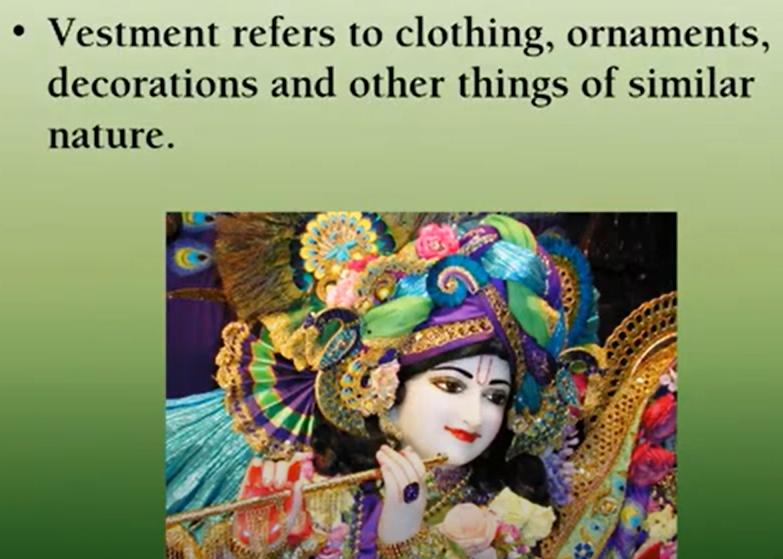
And of course, His hair, He has different hairstyles [Laughs] So He ties His hair in different ways and that will stimulate their love. When He goes to the forest, He often decorates His body with the minerals from the forest. The different clays, different colored clays and they stick it on His body and that will stimulate their love also.
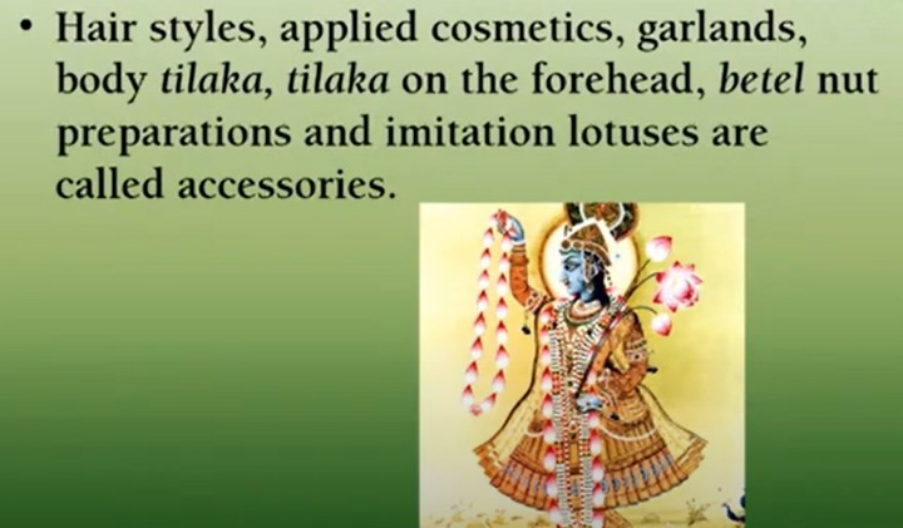
And sometimes the Gopis may paint little pictures on Krishna, patterns on His face or His arms or His body that will also stimulate love. So, the tilak on His forehead will stimulate love. The garlands of Krishna will stimulate love. His betel nut that He chews will stimulate love He often holds a lotus in His hand, so this is often a stimulus for love also.
And as well, obviously His flute is a stimulus for love. So of course seeing the flute is a stimulus, but also hearing the flute is a stimulus. Krishna also has a buffalo horn that is also a stimulus for love Sometimes he may blow that also. The conch is a stimulus for love, of course usually we see the conch associated with Vishnu [Laughs].

Krishna’s footprints – they are a very great stimulus. So when Krishna walks in the sand, that sand picks up His footprints and it holds those footprints, they don’t disappear, they stay there. So the scriptures describe, I think, 21 symbols on His left and right foot and these are unique to Krishna. For instance, He has the lotus, the flag, the umbrella, the fish, etc [Laughs]. So when he steps on the ground, then not only his footprint is there, but all these marks will show up. And the people, they see those footprints with the marks and they recognize Krishna’s – that’s Krishna’s footprint!! [Laughs]. So then the Tulsi leaf is a stimulus, because Tulsi is always with Krishna. So when the Gopis smell the Tulsi, then they know Krishna is very near.

The devotees of Krishna are stimulus for love also. So when the devotees in Vrindavan see a devotee of Krishna, then they are reminded of Krishna, so their love is stimulated by that. So in the material world, we don’t see Krishna, but we can see devotees. So we recognize the devotees by certain signs. He wears the Vaishnava tilak. He wears Tulsi beads. He may have the names of Krishna painted on his body. So when a devotee sees that other devotee, then that will stimulate his love for Krishna.
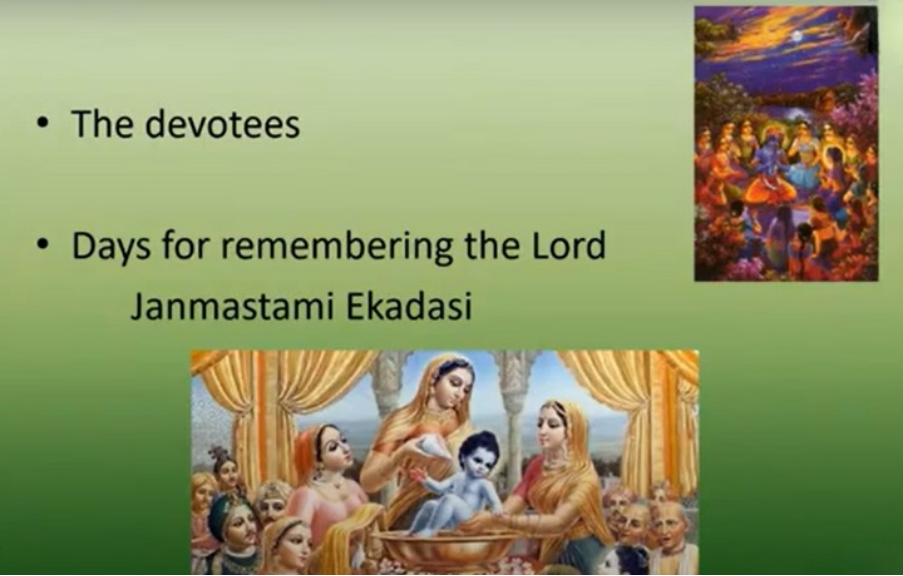
In terms of time, certain days are convenient for remembering Krishna. So that is why we celebrate Jamastami. This is a time that becomes a stimulus for remembering Krishna. So, of course, also we have Ekadasi, Ekadasi is called the “Day of Vishnu”. So this is a stimulus for remembering the Lord. So that’s it. Yeah, so in this way we have a whole series of things I haven’t given details, but in the Nectar of Devotion Rupa Goswami gives a lot of details for each of these items that stimulates the love.
What we have been discussing is all called Vibhava. So, this involves the Vishaya, the object of love, Krishna, the Ashraya, the experiencer of the love, the devotee, and the Uddipana, the stimulus for that love. So, these are all included within Vibhava. So these are an essential aspect of Rasa in fact, you can’t have Rasa unless you have this [Laughs] first of all.
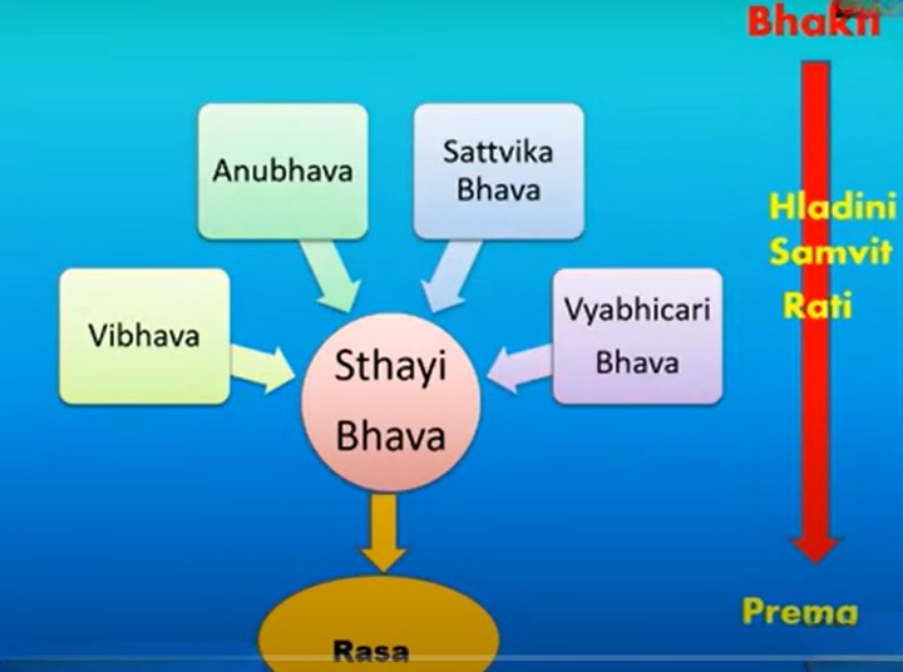
But it is not the only factor in Rasa, there are four other factors. So the other ones will be the manifestations in the devotee. For instance, Anubhavas, Sattvika bhavas, Vyabhicari bhavas. These will appear within the devotee. The Anu Bhavas and Sattvika Bhavas are actions of the devotee. Vyabhicari Bhava and Sthai Bhava are emotions of the devotee. So all of these will manifest because the devotee is perceiving Krishna, the object of love, the Vibhava. And they perceive certain Uddipanas in him. And this will give rise to Anubhava, Sattvika bhavas, Vyabhicari Bhavas and Sthayi bhavas. And when they all mix together, then we get the final product – Rasa.
Now we’re speaking from the devotee’s point of view, but Krishna also experiences Rasa. So He looks at the devotee, that’s the object of His love and then He will have Anubhava, Sattvika bhavas, Vyabhicari bhavas, Sthayi Bhavas in relation to a particular devotee. And this will correspond to the type of devotee. So if the devotee has Sakhya Rasa, then Krishna responds with Sakhya Rasa also or if someone has Vatsalya Rasa, Krishna responds to that Vatsalya Rasa. So Krishna, He is the source of all Rasas and therefore He can express and feel all the Rasas perfectly. The devotees usually have one prominent Rasa only. They may have a secondary one also for instance it may be a mixture of Dasya with Sakhya. But generally they don’t experience all the Rasas. But Krishna manifests all Rasas. So He can do so even if some of the Rasas are contradictory because He is Supreme Lord.
Okay. So that’s the end of the first chapter there Vibhava.
Any question?
Q&A
1) Vibhava is what chapter of Nectar of Devotion?
Oh, I don’t know what chapter it is in the BBT edition. It’s the… It’s called the Southern Section in the… the first chapter of the Southern Section of the four divisions of the Bhakti Rasamrita Sindhu.
2) So in all of the five ingredients of Rasa like Vibhava, Sthayi Bhava, the word Bhava is there, so in this sense, what is the definition of the word Bhava?
Well, it can be condition or situation or state. So for instance, Vibhava is often translated by scholars into prerequisite conditions [Laughs] preliminary conditions or whatever. In Anubhavas ‘anu’ means afterwards, so subsequent conditions. Sattvika Bhavas means certain conditions that arise from deep emotional experiences [Laughs]. And Vyabhicari Bhava means temporary conditions, very transitory emotional states. And Sthayi Bhava is the permanent emotional condition or the basis of Rasa.
3) So in devotion there are three stages like Sadhana, Bhava and Prema. So in that sense how should we define Bhava?
Okay, well of course that’s sthayi bhava. That’s Bhava which also refers to the Sthayi Bhava. Here [Laughs] in this diagram here so it’s defined as a mixture of Hladini and Samvid Shaktis. So that manifests at the Bhava stage by doing Sadhana. So this becomes fixed in the Jiva.

4) So for example if we were to translate in Japanese like Prema bhakti and Bhava bhakti what would be the best way to translate it?
HH Bhanu Swami Maharaj: Bhava bhakti [Laughs]… very difficult [Laughs]… use “katakana” maybe Bhava and Prema [Laughs].
Devotee Translator: Prema like a pure unalloyed pure and then Bhava is um…
HH Bhanu Swami Maharaj: Yeah well we can say that often in sanskrit they they call Bhava, the sprout of Prema “Prema ankura”, the sprout of Prema .
But how you translate Prema in Japanese, I don’t know how do you want to translate that [Laughs].
Devotee: Gave a clarification in Japanese that they use the word coco [unclear] to refer prema.
HH Bhanu Swami Maharaj: So that’s more like a Joy or something like that. It’s not necessarily love, so it’s a little different sometimes the subject above us can be called coco [unclear] it’s their ecstatic symptoms.
5) So in Bhava like the love is not a hundred percent pure yet?
Yeah it is described that, it’s just a sprout. So it’s got the ingredients but not so intensely felt as Prema. So in Bhava stage there’s some slight impurities because of that you can even fall from Bhava stage, but you cannot fall from Prema.
6) Is it adequate/appropriate to translate Prema as pure love?
Oh maybe it’s a spiritual love [Laughs]. Because pure love also probably in the material world that may have the same words [Laughs]. Of course we’ll have the same problem even in Indian languages, because like in Hindi, Prema also means material love [Laughs]. They talk about the Prema of the two lovers you know in the movie.
7) Is Tulasi Maharani in Madhurya rasa ? And also if there is a story explaining why Tulasi is always with Krishna please kindly share?
Yes, Madhurya rasa and there is a story. Its actually in the Puranas, and our acharyas really don’t talk about that [Laughs].
8) Hare Krishna Maharaj, is it possible to experience these Bhavas before svarupa-siddhi?
Well you can experience.. you begin to experience this in the Bhava stage which is still some impurity there. So at that stage your svarup also begins to manifest, so in that sense yes your svarup is manifested and you experience but it’s not fully manifested.
Devotee Translator: I’m sorry what is it not fully manifested, the Prema ?
HH Bhanu Swami Maharaj: The Prema is not fully manifested. Your svarupa is manifested but your Prema is not fully manifested. So if you reach Bhava stage, then your Sthayi Bhava is established, which means it maybe Dasya, Sakhya, Vatsalya, Madhurya. So a certain relationship with Krishna is manifesting with a certain taste and if it is a rasa, then there is a Vibhava. Krishna and there’s a devotee so the devotee can have a material body, he has to experience in a spiritual body.
So if you’re having Sakhya rasa, you would have to manifest a cowherd body. If you’re manifesting Madhurya rasa you have a gopi body. You can’t do it with a devotee body obviously, so naturally in the Bhava stage when you have some experience of the Sthayi Bhava and rasa then, your svarup will manifest.
Devotee: So Maharaj, I mean like svarupa siddhi and having Krishna Prema, attaining Krishna Prema, they are the same things right?
HH Bhanu Swami Maharaj : Well it’s a different way of expressing. Svarup siddhi means you’ve manifested your svarup fully, so that’s in terms of manifesting your form. Prema means the experience of love which is ultimately the same thing. You cannot manifest your full love without having your svarup.
Translator: So they are the same thing but different ways?
HH Bhanu Swami Maharaj: Perspective considered [unclear]
9) Dandavat Pranam Maharaj, Maharaj when Krishna is reciprocating with the devotee or in different Rasas, does Krishna still remembers Himself as the supreme person or He forgets His godliness?
Well, if we look at for instance the Damodar pastime, where Krishna is running away from Mother Yasoda and crying, then well we could say, well, He’s supreme lord. So actually He’s just putting on an act for Mother Yasoda. But that would be like false [Laughs]. Well, that wouldn’t be real love if Krishna were only acting.
So, we have to say that while Krishna isn’t thinking I’m Supreme Lord, He’s really identifying with Himself as a young little boy who is the son of Mother Yasoda. Well then we could say, well, how if He’s Supreme Lord, how He can forget [Laughs]? And the answer is that, Krishna is under the control of His devotee. So because of that, we can say his aspect of God gets covered up and He acts exactly like his devotee wants Him to act as a child. So his so-called forgetfulness is not a fault. It’s actually a good quality.
Devotee: Thank you very much Maharaj!
10) So when we are in like the lower stages of Bhakti, we are influenced by the planets. But what are the effects of the planets when one devotee is in Ashakti or Bhava stage?
Well, even in the lower stages technically we’re not affected by planets, because our karma gets destroyed by Bhakti. But a little pattern remains that may look like karma. And why is that? Because we maintain a material body. So as long as we have a body, it has to confirm to some sort of pattern [Laughs], some sequence.
So Krishna lets the pattern of karma continue for that body until you give up that body. So therefore, even a devotee in Prema, he may get sick, he may get an accident or whatever, and say, oh look he’s under the law of karma also, but actually he isn’t [Laughs]. That’s just a pattern that looks like karma [Laughs].
Devotee: Like a vasana, it remains as Vasana ?
HH Bhanu Swami Maharaj: Impressions / desires, you’re talking about?
Devotee: Yeah, pattern, yeah.
HH Bhanu Swami Maharaj : What’s the question? The remain only vasana?
Well, we say that a pattern of karma that looks like karma remains, you can call that a vasana also. But there’s no control of karma, it’s under Krishna. So, everything’s under Krishna at that point in Prema.
Devotee : Even the Bhava, Prema, Bhakti, sometimes devotees seem to be influenced under very much the Saturn or Mangala, like that very passion.
HH Bhanu Swami Maharaj : Well, if there’s bhava, there’s some influence, if there’s Prema, no influence at all. So it’s all simply some pattern only that’s remaining, that is not real karma.
Devotee: Even our stage then already destroyed the karma?
HH Bhanu Swami Maharaj: Yeah, technically, yeah, in most cases. But if you commit offenses, it takes longer for the karmas to get destroyed on the lower stages. For instance, Ajamila had all of his karmas past, present and future destroyed instantly, when he said to his son, your name is Narayana. So all those karmas were gone immediately, but that was because he had no offenses. So when one has some offenses, then it will take longer for the karmas to get destroyed.
11) When Ajamila, he was almost taken by the Yamadutas, the Vishnudutas came, did he go straight back to the Vaikunta ?
No, No. He didn’t have Prema. He got his karmas destroyed, he didn’t have Prema. So he came back to life, and because of the association of the Vishnu Dutas, he began to practice bhakti, then he got Prema and then he went to Vaikunta.
12) Maharaj, like, in this lifetime, till which level we can progress? Can we even touch Asakti? Or before…
HH Bhanu Swami Maharaj: Which stage can we progress?
Devotee: Yeah.
HH Bhanu Swami Maharaj: Well, that’s up to the intensity of your bhakti and the mercy of Krishna.
Devotee: So, like, right now, do you know any examples of devotees on stage of Bhava Bhakti, so that we can have some inspiration?
HH Bhanu Swami Maharaj: Which stage?
Devotee: Bhava Bhakti.
HH Bhanu Sswami Maharaj : Bhava Bhakti ? No, most people are at Nishtha, as far as I can see [Laughs].
13) Hare Krishna Maharaj, Dandavat Pranam. When a devotee leaves the body, before leaving the body, devotee gets to know that in which rasa that devotee is in?
HH Bhanu Swami Maharaj : Well, you only get to know your body when you start getting into bhava. If you don’t reach the stage of bhava, then it’ll have to wait till next lifetime. Then you do, until you get to bhava, then you understand which rasa you have and which form you are now.
14) Maharaj, death means loss of memory. We forget the things we have done in this life. But how, when we leave this body and get into the spiritual body, do we still lose our memory or still it’s intact?
Well, if we have memory of the material world but are in the spiritual world, this would be a contamination. So that cannot happen. Spiritual world is full of Prema. So our only thought is Krishna and how to serve Krishna there. So therefore, there can be no material memories at all.
Devotee: That means, Maharaj, we’ll also lose the memories of all the guides and gurus who have given us all the knowledge to go into the body?
HH Bhanu Swami Maharaj : Well, everything spiritual in the material world gets transferred to the Spiritual world – your attraction to Krishna, your attraction to devotees, attraction to guru, that will be there in the spiritual world in a spiritual form.
But don’t expect the guru to come with a material form in the spiritual world. So that’s why we think of guru as a Manjari or as a Gopi or whatever like that [Laughs]. A guide in the spiritual world suitable to our particular rasa.
So the forms are somewhat transformed in the spiritual world. But nevertheless, all spiritual relationships are eternal. So therefore, those relationships can continue in the spiritual world also.
15) Can I ask one question to that? So, for example, there is like a very nice devotee couple, but they serve Krishna really well together. Like in the spiritual world, there are no like marriages other than with Krishna or they have like..
Oh, no. Well, like we find in Vaikuntha even there is men and women. They should do this and they had consorts, etc., So in Goloka, then we have in Vrindavan, we have the elders married. So we have Nanda and Yasoda and we have elders married to cowherd women, etc, and they have children, etc. So there can be combinations there in the spiritual world also.
However, those relationships are all centered on Krishna, not on each other. The material world, husband and wife, that’s the main attraction to each other. Spiritual world, that is not there. Both are attracted to Krishna. They’re both serving Krishna.
16) So Maharaj, if there is no birth in spiritual planets, then why is there any relationship or concept of birth?
As I said, they’re all related to Krishna. So they’re only husband and wife for pastimes. So we have husband and wife and they have a cowherd boy. And the cowherd boy is playmate of Krishna [Laughs]. They are elders and they have Vatsalya Rasa for Krishna. So it’s only for pastimes.
Devotee: And the age remains eternal like if somebody is a cowherd boy.
HH Bhanu Swami Maharaj : Yeah, eternally. Yeah, they don’t grow [Laughs]…
Devotee: Thank you, Maharaj. Dandavat Pranams.
17) So if Krishna, if some devotee had attraction for baby Krishna, someone had for attraction for like a ten-year-old Krishna. Yeah. How does it happen?
Well, if they have attraction for baby Krishna, they’re born in Vatsalya Rasa. But in the spiritual world, Krishna is Kaishora age. So when He’s Kaishora age, they can also see Krishna in almost a baby form. So they can still stimulate their Vatsalya Rasa but they can also come to the material world and experience the pastimes here where Krishna is actually a small child.
18) Hare Krishna Maharaj. Please accept my humble obeisances. Maharaj, So you said that you essentially see devotees mostly in Nishtha level. So I’m wondering, when essentially a devotee can reach the spiritual world, I mean, if somebody leaves his body in Nistha level, then what is the next destination?
Okay, so he continues wherever he left off in the next lifetime, and continues his Sadhana until he gets to the next stage, or the next stage, or the next stage.
If he’s not complete, then he goes another lifetime, until he gets to Bhava and then to Prema. So he continues.
19) So until and unless we reach that Bhava or Prema level, so we cannot reach the spiritual world?
No, no. Otherwise, we’d be impure in the spiritual world [Laughs]. But, of course, there’s always the extraordinary mercy of devotees and Krishna, by which one can jump. And even if one is impure, then one could make a big jump to Bhava or to Prema. But that’s rare.
20) So Maharaj you were mentioning that Nishtha if they don’t complete next life they start from where they left off… In the Bhagavad Gita it is says that, when one doesn’t like complete then they go to the heavenly planets, and then they enjoy and then they come back to the earthly planet and then they continue? Does that apply to the devotees who are in the Nishtha stage?
Well, if you have some material desires [Laughs], Krishna may put you there. But if you’re practicing pure bhakti, He makes arrangements, so you can continue pure bhakti.
21) In Nishtha, it is said that 50% is Maya and 50% is Krishna. But is there a time when you completely throw away the desire to enjoy the material things? So, that means there are two types of Nishtha, one who has no material desires, so they can stay and do pure bhakti, and then there’s one who does have material desires?
Well, they both have material desires, but when you’re doing your bhakti, you may aspire for Krishna fulfilling your material desires in your bhakti. So, if that gets mixed with your bhakti, then Krishna will also try to fulfill that.
If you’re saying, OK, I have my material desires, but as far as I know, I’m trying to get out of the material world and simply serve Krishna purely, then Krishna is not inclined to you know reward you with material things. He’ll just give you more pure bhakti…more pure bhakti, even though you still are in the material world.
Translator devotee: So, it’s a matter like of that person’s intention? Like what they are…?
HH Bhanu Swami Maharaj : Yes, the intention…yeah….yeah….
Devotee: So, even if they’re both the same Nishtha, the latter, the one that is aspiring for pure service, is higher than the…
HH Bhanu Swami Maharaj : Yeah, definitely. Always pure bhakti is better than mixed bhakti [Laughs].
22) Hare Krishna Maharaj. The person or the devotee who is having Krishna Prema is an Uttama Adhikari Vaishnava, right?
HH Bhanu Swami Maharaj: Yeah.
Devotee: Thank you, Maharaj.
HH Bhanu Swami Maharaj: Okay, that’s it.
Devotee: Thank you very much, Maharaj.
HH Bhanu Swami Maharaj: Hare Krishna!! Hari bol !!


